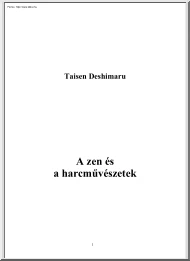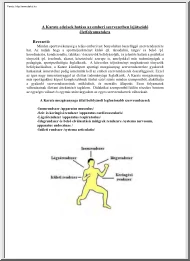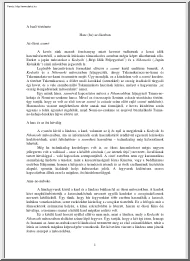Datasheet
Year, pagecount:2016, 3 page(s)
Language:English
Downloads:2
Uploaded:July 11, 2019
Size:556 KB
Institution:
-
Comments:
Attachment:-
Download in PDF:Please log in!
Comments
No comments yet. You can be the first!Most popular documents in this category
Content extract
Source: http://www.doksinet What is the most important difference between aikido and other martial arts? Morihiro Saito Sensei: The main difference is surely that there are no tournaments or competitions in aikido. The Founder studied a variety of different martial arts, competed against many other disciplines and realized that competition is not necessary. The aim is to create, with the assistance of the traditional budo style of aikido, a beautiful world that is like the house of a big family; to never compete again. The Founder wrote a poem that says, "This beautiful form of heaven and earth is a single family created by the guardian spirit." This world is like the house of a big family. This is the feeling of aikido Besides that, this martial art is completely rational. I think that every martial art is rational; however, for aikido this is especially true. Anyone can practice, understand, and reason with it. It is not a martial art only for strong or fit people Children
and elderly alike can all enjoy training and become good Aikidoka. I have tried many different martial arts, but I think it was this that I liked about aikido What is the significance of the weapons in Takemusu Aikido and how do they relate to the taijutsu techniques? O-Sensei & Saito Sensei Morihiro Saito Sensei: Aikido is a martial art. No matter how good one is in judo, if he or she takes a kendo sword and looses against a student, he or she is not a Budoka, but a Judoka. Even as number one in Japan in kendo, if he or she puts on a judogi and is thrown by a student, he or she is a Kendoka and not a Budoka. OSensei (The Founder) says, "This is not good." Everything is a whole, an entirety. That is why in aikido, even if the principle of the sword is formative, all the movements in the body techniques, as well as in the weapons techniques, are entirely similar. That is why weapon techniques are indispensable in aikido They are a part of it. Some people say aikido is a
collection of techniques, but that is not true How shall I put it? Each of them is contained in the whole. No matter which of the three you take out, bokken, jo, or taijutsu, alone it is not complete aikido. That is why weapons are an especially important part of aikido. Many foreigners in Japan have difficulties understanding Japanese culture. How can they gain this understanding from aikido? Morihiro Saito Sensei: Through aikido, human beings can become good people finding greatness coming from within. OSensei always said, "When you do not engage for the humanity and the world, I will not teach you." Because of that you should strengthen your body and learn through the "principle of Aiki" how to connect with everything, come in harmony with everything, and engage for humanity and the world. OSensei would answer the question, "What is Aikido?", by saying that it is a martial art of education with the aim of creating a beautiful and good society. That
means without competition This is the demand of OSensei. That is why competition is not necessary If it should happen that you are Source: http://www.doksinet confronted with a real situation where you have to defend yourself physically, the way you have trained in aikido is more useful than competitions. There are so many techniques of selfdefense without violence In a competition, people soon start to prefer a certain technique and wait for an opportunity to use it. That is the moment where they can be overcome That is why OSensei said that we should always train with seriousness and the feeling that we are surrounded by numerous attackers. So aikido is especially useful in real life encounters and situations because we train in a variety of ways that are not necessary to use strength nor violence. What is the use of aikido in everyday life? O-Sensei Noma Dojo - 1936 Morihiro Saito Sensei: In the first place, and mainly, aikidos use in everyday life is to develop awase, (i.e the
ability to blend, harmonize) A variation of a principle of aikido can be applied to anyone, big or small, obese or slim, stiff or supple. This is why you should not clash or collide and get into a conflict, but instead go with the movements of another. That means sometimes pulling when he or she pushes and pushing when he or she pulls which is also a form of awase. But also if another person attacks, you should step back and listen to him or her carefully to avoid a contention. Or when the other one is a restraint person, you should spur on and encourage them. In this way, you can use aikido for many things. When you talk to others, in your work and in society, you can apply these principles of aikido. That is why almost every master often says to their students, "When you enter the working world, you shall use the principles of aikido; you shall use aikido in society." So if you practice a lot of aikido, you can develop sudden insights and there are many useful ways to use
aikido. In this sense, it is like that with every martial art, but in aikido, it is more prevalent. Many masters do not talk so much about OSenseis techniques, but rather a lot about his thoughts and his philosophy. What do you think about that, Sensei? Morihiro Saito Sensei: There are many aikido masters, but only a few who had a lot of teaching from OSensei himself. In true budo, you do not express yourself in words or writing "God does not give grace to those who talk too much." This is what OSensei said Usually people who talk a lot and write good essays cannot also do good aikido. It is better not to talk too much, but to learn with the body. It is true that people are different. Some learn with their minds by listening, while others learn with their bodies by watching. But the Founder always said, "If you show someone the way, you first have to do it yourself, demonstrate and show it." That means, for example, you make them understand irimi by entering behind
your partner and not pulling them to ones own body. So the Founder did not like to talk too much. But such a philosophical perspective is also important. When OSensei started to talk about aikido, it became tales about God Each master Source: http://www.doksinet probably has his own philosophies, but I do not like to talk too much. Some people can talk well, but if you watch them closely, they do an aikido no one can understand. It is not their fault because they were not taught by The Founder himself. After the Second World War, OSensei did not have work. In order to keep his martial art alive, from that moment on he started to enthusiastically explore Aikido in Iwama by worshipping the Budo Guardian Spirits and praying every morning and evening. And so Takemusu Aikido was created He said the former aikido was not the "true" aikido. It may not be incorrect aikido, but this is what OSensei said. In Takemusu Aikido, bit by bit, new techniques appear spontaneously This never
stops, it is infinite like a spring. This is Takemusu Therefore, for every technique, there is a basic form. It is necessary to learn these basics in their correct order to be able to understand the real aikido. What is the significance of kiai? M. Saito Sensei - Kiai - Morihiro Saito Sensei: Kiai is something that comes completely naturally when you have ki or energy. It comes by itself There are also methods to suppress kiai, but with OSensei, it was different. He said that you should shout from the abdomen Indeed in martial arts a big kiai is a sign of good energy. It is important to make kiai Training without kiai does not make big progress. It is not powerful and has no energy With a big kiai, a training is full of energy. That is why it is better to shout out loud OSensei always said, "What kind of kiai is that? Make a bigger kiai! Go outside and let the sparrows fall from the trees!" He always said proudly, "When I once made a kiai at the newspaper company,
Asahi Shimbun, fourteen people fell from their chairs." When you have to train where you cannot make noise, for example because the neighbors complain, you cant help but be silent. But wherever possible, you should shout out loud. Sensei, thank you very much
and elderly alike can all enjoy training and become good Aikidoka. I have tried many different martial arts, but I think it was this that I liked about aikido What is the significance of the weapons in Takemusu Aikido and how do they relate to the taijutsu techniques? O-Sensei & Saito Sensei Morihiro Saito Sensei: Aikido is a martial art. No matter how good one is in judo, if he or she takes a kendo sword and looses against a student, he or she is not a Budoka, but a Judoka. Even as number one in Japan in kendo, if he or she puts on a judogi and is thrown by a student, he or she is a Kendoka and not a Budoka. OSensei (The Founder) says, "This is not good." Everything is a whole, an entirety. That is why in aikido, even if the principle of the sword is formative, all the movements in the body techniques, as well as in the weapons techniques, are entirely similar. That is why weapon techniques are indispensable in aikido They are a part of it. Some people say aikido is a
collection of techniques, but that is not true How shall I put it? Each of them is contained in the whole. No matter which of the three you take out, bokken, jo, or taijutsu, alone it is not complete aikido. That is why weapons are an especially important part of aikido. Many foreigners in Japan have difficulties understanding Japanese culture. How can they gain this understanding from aikido? Morihiro Saito Sensei: Through aikido, human beings can become good people finding greatness coming from within. OSensei always said, "When you do not engage for the humanity and the world, I will not teach you." Because of that you should strengthen your body and learn through the "principle of Aiki" how to connect with everything, come in harmony with everything, and engage for humanity and the world. OSensei would answer the question, "What is Aikido?", by saying that it is a martial art of education with the aim of creating a beautiful and good society. That
means without competition This is the demand of OSensei. That is why competition is not necessary If it should happen that you are Source: http://www.doksinet confronted with a real situation where you have to defend yourself physically, the way you have trained in aikido is more useful than competitions. There are so many techniques of selfdefense without violence In a competition, people soon start to prefer a certain technique and wait for an opportunity to use it. That is the moment where they can be overcome That is why OSensei said that we should always train with seriousness and the feeling that we are surrounded by numerous attackers. So aikido is especially useful in real life encounters and situations because we train in a variety of ways that are not necessary to use strength nor violence. What is the use of aikido in everyday life? O-Sensei Noma Dojo - 1936 Morihiro Saito Sensei: In the first place, and mainly, aikidos use in everyday life is to develop awase, (i.e the
ability to blend, harmonize) A variation of a principle of aikido can be applied to anyone, big or small, obese or slim, stiff or supple. This is why you should not clash or collide and get into a conflict, but instead go with the movements of another. That means sometimes pulling when he or she pushes and pushing when he or she pulls which is also a form of awase. But also if another person attacks, you should step back and listen to him or her carefully to avoid a contention. Or when the other one is a restraint person, you should spur on and encourage them. In this way, you can use aikido for many things. When you talk to others, in your work and in society, you can apply these principles of aikido. That is why almost every master often says to their students, "When you enter the working world, you shall use the principles of aikido; you shall use aikido in society." So if you practice a lot of aikido, you can develop sudden insights and there are many useful ways to use
aikido. In this sense, it is like that with every martial art, but in aikido, it is more prevalent. Many masters do not talk so much about OSenseis techniques, but rather a lot about his thoughts and his philosophy. What do you think about that, Sensei? Morihiro Saito Sensei: There are many aikido masters, but only a few who had a lot of teaching from OSensei himself. In true budo, you do not express yourself in words or writing "God does not give grace to those who talk too much." This is what OSensei said Usually people who talk a lot and write good essays cannot also do good aikido. It is better not to talk too much, but to learn with the body. It is true that people are different. Some learn with their minds by listening, while others learn with their bodies by watching. But the Founder always said, "If you show someone the way, you first have to do it yourself, demonstrate and show it." That means, for example, you make them understand irimi by entering behind
your partner and not pulling them to ones own body. So the Founder did not like to talk too much. But such a philosophical perspective is also important. When OSensei started to talk about aikido, it became tales about God Each master Source: http://www.doksinet probably has his own philosophies, but I do not like to talk too much. Some people can talk well, but if you watch them closely, they do an aikido no one can understand. It is not their fault because they were not taught by The Founder himself. After the Second World War, OSensei did not have work. In order to keep his martial art alive, from that moment on he started to enthusiastically explore Aikido in Iwama by worshipping the Budo Guardian Spirits and praying every morning and evening. And so Takemusu Aikido was created He said the former aikido was not the "true" aikido. It may not be incorrect aikido, but this is what OSensei said. In Takemusu Aikido, bit by bit, new techniques appear spontaneously This never
stops, it is infinite like a spring. This is Takemusu Therefore, for every technique, there is a basic form. It is necessary to learn these basics in their correct order to be able to understand the real aikido. What is the significance of kiai? M. Saito Sensei - Kiai - Morihiro Saito Sensei: Kiai is something that comes completely naturally when you have ki or energy. It comes by itself There are also methods to suppress kiai, but with OSensei, it was different. He said that you should shout from the abdomen Indeed in martial arts a big kiai is a sign of good energy. It is important to make kiai Training without kiai does not make big progress. It is not powerful and has no energy With a big kiai, a training is full of energy. That is why it is better to shout out loud OSensei always said, "What kind of kiai is that? Make a bigger kiai! Go outside and let the sparrows fall from the trees!" He always said proudly, "When I once made a kiai at the newspaper company,
Asahi Shimbun, fourteen people fell from their chairs." When you have to train where you cannot make noise, for example because the neighbors complain, you cant help but be silent. But wherever possible, you should shout out loud. Sensei, thank you very much





 Just like you draw up a plan when you’re going to war, building a house, or even going on vacation, you need to draw up a plan for your business. This tutorial will help you to clearly see where you are and make it possible to understand where you’re going.
Just like you draw up a plan when you’re going to war, building a house, or even going on vacation, you need to draw up a plan for your business. This tutorial will help you to clearly see where you are and make it possible to understand where you’re going.